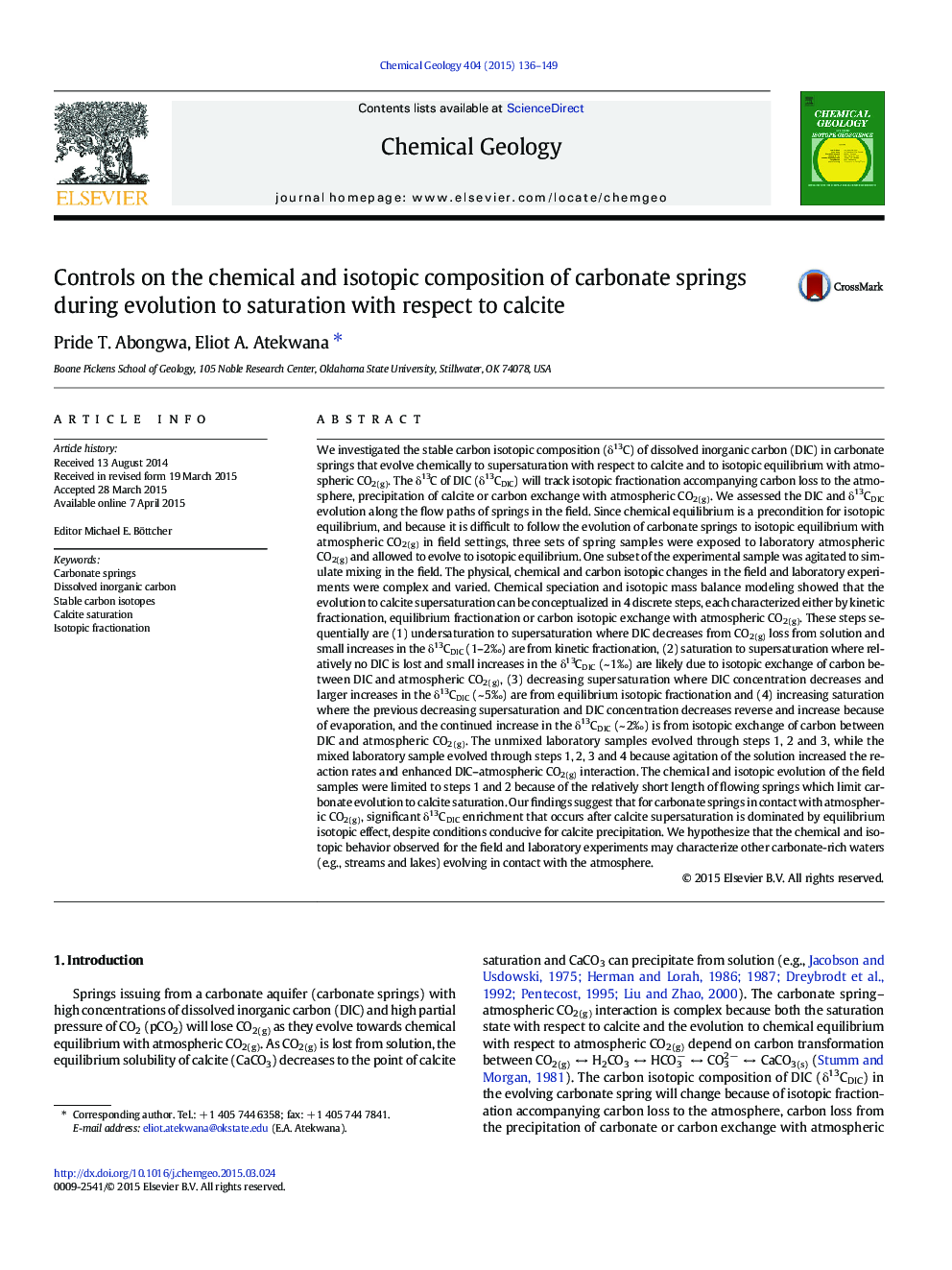| کد مقاله | کد نشریه | سال انتشار | مقاله انگلیسی | نسخه تمام متن |
|---|---|---|---|---|
| 4698514 | 1637569 | 2015 | 14 صفحه PDF | دانلود رایگان |
• We assessed carbon isotopes (δ13C) of dissolved inorganic carbon (DIC) in evolving carbonate springs.
• The δ13C increased < 2‰ from kinetic fractionation during increasing saturation.
• The δ13C increased ~ 5‰ from equilibrium fractionation during decreasing supersaturation.
• The δ13C increased < 2‰ from isotopic exchange during increasing supersaturation.
• Carbonate precipitation contributed < 2‰ to the δ13C of DIC in evolving carbonate springs.
We investigated the stable carbon isotopic composition (δ13C) of dissolved inorganic carbon (DIC) in carbonate springs that evolve chemically to supersaturation with respect to calcite and to isotopic equilibrium with atmospheric CO2(g). The δ13C of DIC (δ13CDIC) will track isotopic fractionation accompanying carbon loss to the atmosphere, precipitation of calcite or carbon exchange with atmospheric CO2(g). We assessed the DIC and δ13CDIC evolution along the flow paths of springs in the field. Since chemical equilibrium is a precondition for isotopic equilibrium, and because it is difficult to follow the evolution of carbonate springs to isotopic equilibrium with atmospheric CO2(g) in field settings, three sets of spring samples were exposed to laboratory atmospheric CO2(g) and allowed to evolve to isotopic equilibrium. One subset of the experimental sample was agitated to simulate mixing in the field. The physical, chemical and carbon isotopic changes in the field and laboratory experiments were complex and varied. Chemical speciation and isotopic mass balance modeling showed that the evolution to calcite supersaturation can be conceptualized in 4 discrete steps, each characterized either by kinetic fractionation, equilibrium fractionation or carbon isotopic exchange with atmospheric CO2(g). These steps sequentially are (1) undersaturation to supersaturation where DIC decreases from CO2(g) loss from solution and small increases in the δ13CDIC (1–2‰) are from kinetic fractionation, (2) saturation to supersaturation where relatively no DIC is lost and small increases in the δ13CDIC (~ 1‰) are likely due to isotopic exchange of carbon between DIC and atmospheric CO2(g), (3) decreasing supersaturation where DIC concentration decreases and larger increases in the δ13CDIC (~ 5‰) are from equilibrium isotopic fractionation and (4) increasing saturation where the previous decreasing supersaturation and DIC concentration decreases reverse and increase because of evaporation, and the continued increase in the δ13CDIC (~ 2‰) is from isotopic exchange of carbon between DIC and atmospheric CO2(g). The unmixed laboratory samples evolved through steps 1, 2 and 3, while the mixed laboratory sample evolved through steps 1, 2, 3 and 4 because agitation of the solution increased the reaction rates and enhanced DIC–atmospheric CO2(g) interaction. The chemical and isotopic evolution of the field samples were limited to steps 1 and 2 because of the relatively short length of flowing springs which limit carbonate evolution to calcite saturation. Our findings suggest that for carbonate springs in contact with atmospheric CO2(g), significant δ13CDIC enrichment that occurs after calcite supersaturation is dominated by equilibrium isotopic effect, despite conditions conducive for calcite precipitation. We hypothesize that the chemical and isotopic behavior observed for the field and laboratory experiments may characterize other carbonate-rich waters (e.g., streams and lakes) evolving in contact with the atmosphere.
Journal: Chemical Geology - Volume 404, 26 May 2015, Pages 136–149
